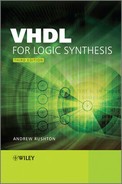Book Description
Making VHDL a simple and easy-to-use hardware description language
Many engineers encountering VHDL (very high speed integrated circuits hardware description language) for the first time can feel overwhelmed by it. This book bridges the gap between the VHDL language and the hardware that results from logic synthesis with clear organisation, progressing from the basics of combinational logic, types, and operators; through special structures such as tristate buses, register banks and memories, to advanced themes such as developing your own packages, writing test benches and using the full range of synthesis types.
This third edition has been substantially rewritten to include the new VHDL-2008 features that enable synthesis of fixed-point and floating-point hardware. Extensively updated throughout to reflect modern logic synthesis usage, it also contains a complete case study to demonstrate the updated features.
Features to this edition include:
a common VHDL subset which will work across a range of different synthesis systems, targeting a very wide range of technologies
a design style that results in long design lifetimes, maximum design reuse and easy technology retargeting
a new chapter on a large scale design example based on a digital filter from design objective and design process, to testing strategy and test benches
a chapter on writing test benches, with everything needed to implement a test-based design strategy
extensive coverage of data path design, including integer, fixed-point and floating-point arithmetic, logic circuits, shifters, tristate buses, RAMs, ROMs, state machines, and decoders
Focused specifically on logic synthesis, this book is for professional hardware engineers using VHDL for logic synthesis, and digital systems designers new to VHDL but familiar with digital systems. It offers all the knowledge and tools needed to use VHDL for logic synthesis. Organised in themed chapters and with a comprehensive index, this complete reference will also benefit postgraduate students following courses on microelectronics or VLSI/ semiconductors and digital design.
Table of Contents
- Cover
- Title Page
- Copyright
- Preface
- List of Figures
- List of Tables
- Chapter 1: Introduction
- Chapter 2: Register-Transfer Level Design
- Chapter 3: Combinational Logic
- Chapter 4: Basic Types
- Chapter 5: Operators
- Chapter 6: Synthesis Types
- Chapter 7: Std_Logic_Arith
- Chapter 8: Sequential VHDL
- Chapter 9: Registers
- Chapter 10: Hierarchy
- Chapter 11: Subprograms
- Chapter 12: Special Structures
- Chapter 13: Test Benches
- 13.1 Test Benches
- 13.2 Combinational Test Bench
- 13.3 Verifying Responses
- 13.4 Clocks and Resets
- 13.5 Other Standard Types
- 13.6 Don't Care Outputs
- 13.7 Printing Response Values
- 13.8 Using TextIO to Read Data Files
- 13.9 Reading Standard Types
- 13.10 TextIO Error Handling
- 13.11 TextIO for Synthesis Types
- 13.12 TextIO for User-Defined Types
- 13.13 Worked Example
- Chapter 14: Libraries
- Chapter 15: Case Study
- Appendix A: Package Listings
- A.1 Package Standard
- A.2 Package Standard_Additions
- A.3 Package Std_Logic_1164
- A.4 Package Std_Logic_1164_Additions
- A.5 Package Numeric_Std
- A.6 Package Numeric_Std_Additions
- A.7 Package Fixed_Float_Types
- A.8 Package Fixed_Pkg
- A.9 Package Float_Pkg
- A.10 Package TextIO
- A.11 Package Standard_Textio_Additions
- A.12 Package Std_Logic_Arith
- A.13 Package Math_Real
- Appendix B: Syntax Reference
- References
- Index
